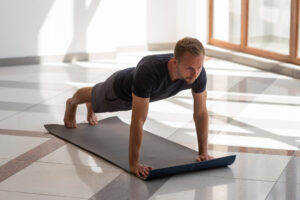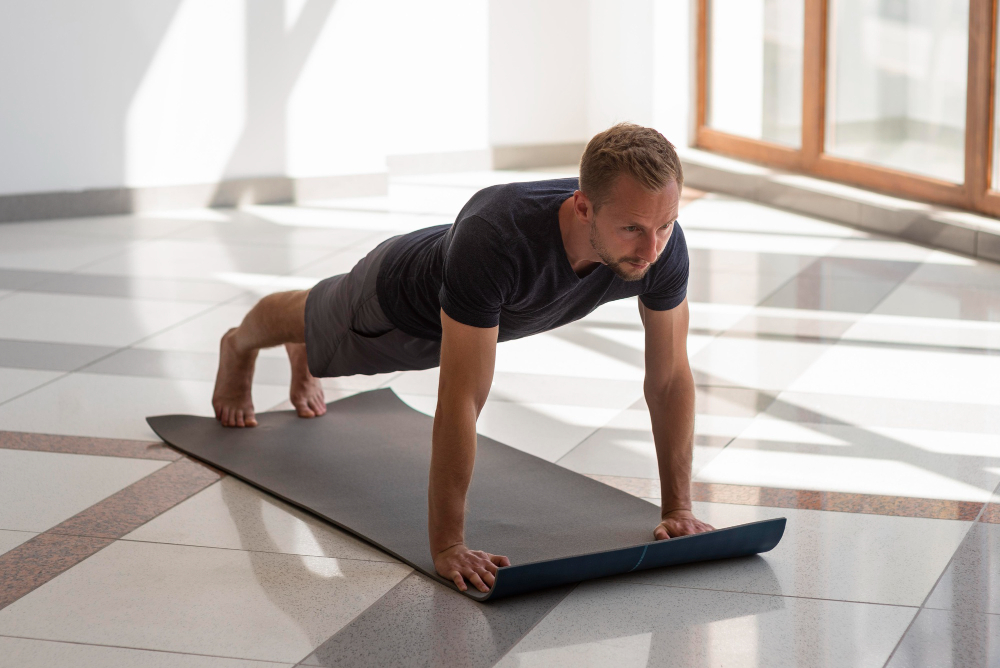The Complete Guide to Core Exercises:
Because of its incomparable advantages, core exercises frequently take center stage when it comes to fitness. Anyone may benefit from having a strong core because it is vital to general health and function, not just athletes. We’ll go into great detail about core exercises in this book, along with their advantages and some useful workouts you can add to your program.
What Kind of Exercises Are Fundamentals?
The muscles in your lower back, hips, pelvis, and abdomen are the focus of core exercises. The strength and stability of your body are derived from these muscles. Contrary to popular assumption, the core is made up of several muscle groups that cooperate to stabilize your spine and promote movement. It is not simply the abs.
Advantages of Core Exercises:
- Enhanced Balance and Stability: As you age, a strong core is especially important since it lowers your chance of falls and accidents.
- Enhanced Athletic Performance: A strong core aids in the transfer of power to your limbs, which enhances your performance whether you’re lifting weights, running, or participating in sports.
- Decreased Back discomfort: Your spine is supported by your core strength, which helps both prevent and treat lower back discomfort.
- Improved Posture: Maintaining good posture helps avoid slouching and the discomfort that goes along with it. Strong core muscles help with this.
- Functional Fitness: A strong core makes daily tasks like lifting, bending, and twisting safer and easier.
Crucial Core Exercises:
You should incorporate a range of workouts into your program to develop a strong core. These are a few efficient core workouts that focus on various core muscle groups:
1. Plank:
- How to Do It: Place your weight on your forearms and begin in the push-up posture with your elbows bent. Maintain a straight body from head to heels.
- Benefits: Increases endurance and stability by using a variety of core muscles.
2. Twists in Russian:
- How to Do It: Hold a medicine ball or weight while sitting on the floor with your knees bent and a small back slant. Move your torso in a sideways motion.
- Benefits: Increases rotational strength and targets the obliques.
3. Cycle Crunches:
- How to Do It: While lying on your back, raise your legs so that they are in a tabletop position. Then, pedaling back and forth, touch your elbows to the opposing knees.
- Benefits: Works the entire core, but especially the obliques and rectus abdominis.
4. Leg Lifts:
- How to Do It: With your legs straight, lie on your back. Reach out toward the ceiling with your legs, then return them to the floor without touching it.
- Benefits: Enhances hip flexor and lower abdominal strength.
5. Bird-Dog:
- How to Do It: From a hands-and-knees position, simultaneously extend one arm and the other leg, then alternate sides.
- Benefits: Works the glutes and lower back, enhances balance and coordination.
6. Climbers of the Mountains:
- How to Do It: Assume a plank position at first, then quickly alternate between bringing one knee to your chest.
- Benefits: Cardiovascular workout that tones the shoulders and core.
7. Dead Bug:
- How to Do It: Assume a prone position, extending your arms skyward and placing your legs in a tabletop posture. Simultaneously lower one arm and the other leg, then go back to the beginning position and alternate sides.
- Benefits: Strengthens lower abs and improves stability and coordination.
Creating a Core Workout Routine:
Including movements that work every part of the core is crucial when designing a core training program. To get you started, consider this example routine:
Warm-Up (5-10 minutes):
Try some light aerobics, like jumping jacks or running, to get your muscles and circulation circulating.
Main Workout (3 sets of each exercise)
- Plank: Maintain for 30–60 seconds.
- 20 reps on each side for Russian twists.
- 20 repetitions per side for bicycle crunches.
- 15 reps of leg raises.
- 15 reps per side for the bird-dog.
- Mountain Goats: thirty seconds.
- Dead Bug: fifteen reps on each side.
Allow to cool (5–10 minutes)
Stretching gently, with an emphasis on the lower back and core.
Tips for Efficient Core Exercise:
- The Secret Is Consistency: For best effects, include core workouts in your regimen two to three times a week at the very least.
- Put Form First: To avoid injuries and make sure you are hitting the muscles properly, use proper form.
- Breathe: When doing core workouts, don’t hold your breath. Breathe out while you’re exerting yourself and in when you’re relaxing.
- Advance Gradually: As you strengthen your core, start with simple exercises and work your way up to more challenging ones.
- When combined with strength and cardio training: A well-rounded exercise program will improve core strength and general fitness.
Common Mistakes to Avoid:
- When Hurrying Through Exercises: For maximum muscular engagement, concentrate on deliberate motions as opposed to rapid ones.
- Ignoring the Lower Back: To keep your balance and avoid injuries, make sure your exercise regimen includes lower back strengthening activities.
- Ignoring Pain: Sharp pain is abnormal; discomfort is natural. Pay attention to your body and adjust the workouts as needed.
- Overtraining: Don’t overdo core exercises; instead, give your muscles time to heal. Days off are crucial.

Conclusion:
A robust core serves as the cornerstone of a functional, healthy body. You may increase overall performance, lower your chance of injury, and improve stability by including a range of core workouts in your regimen. For optimal results, keep in mind to progress gradually, maintain perfect technique, and mix your core exercises with different types of training. Accept the journey toward developing a stronger core and reap the many advantages that it offers.
Frequently Asked Questions:
1. How often should I do core exercises?
Generally speaking, you should include core exercises in your program two to three times a week. Your muscles can properly recover and strengthen at this frequency. However, you may be able to work on your core more frequently if you’re targeting other muscle groups or doing low-intensity workouts. As recovery is essential for promoting muscle growth and avoiding injuries, you should always pay attention to your body and make sure you’re not overtraining.
2. Can core exercises help reduce belly fat?
Although core exercises help to tone and develop the muscles in your abdomen, they won’t guarantee that your belly fat will go down. Combining cardiovascular exercise, strength training, and a nutritious diet leads to fat loss. Over time, you can create a leaner, more toned stomach by incorporating core exercises into a comprehensive fitness plan that also includes cardio and a healthy diet. Recall that the secret is to reduce body fat overall; reducing fat in a particular place is not real.
3. Are core exercises safe for everyone, including those with back pain?
For those who suffer from back discomfort, core exercises can be helpful, but it’s crucial to select the appropriate ones and execute them properly. Lower back strengthening exercises, such as planks and birddogs, can improve spine stability and support, which can help prevent and treat back discomfort. But before beginning any new workout program, it’s important to speak with a doctor or physical therapist if you already have back problems. They can offer tailored advice and guarantee that your regimen is secure and beneficial for your particular ailment.
Like this:
Like Loading...


